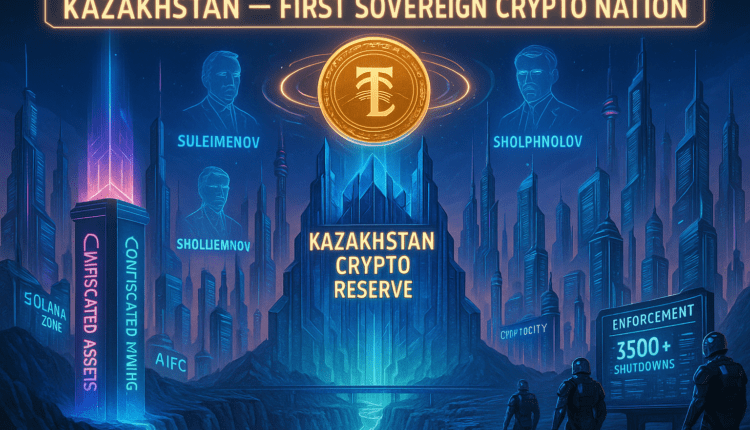Kazakhstan Launches State Crypto Reserve Backed by Mining & Seized Assets

Kazakhstan is creating a national crypto reserve fueled by confiscated assets and government-supported mining. It’s a bold move to anchor digital assets in state policy.
Kazakhstan has unveiled a strategic initiative to launch a state-backed crypto reserve, signaling a bold leap into sovereign digital asset management. Timur Suleimenov, Chairman of the National Bank, announced that the fund will be financed through two main channels: confiscated criminal crypto assets and proceeds from government-supported mining operations.
Suleimenov emphasized that the reserve will adhere to international standards of sovereign fund governance, including institutional accountability, transparent accounting, secure storage, and long-term sustainability. Details on the reserve’s structure are currently being shaped in collaboration with law enforcement and relevant government agencies, positioning Kazakhstan as the first Central Asian country to establish a sovereign digital reserve.
Online advertising service 1lx.online
From Mining Boom to Regulated Innovation
Kazakhstan’s digital finance journey began in 2021, when mining firms from China relocated en masse due to Beijing’s crypto ban. At its peak, Kazakhstan accounted for over 27% of global Bitcoin mining, thanks to its low-cost electricity and minimal regulation.
However, this mining surge placed an enormous burden on the national grid, prompting a rethink of policy. By 2023, tighter regulations had reduced the country’s mining share to just 4% globally. Under the new framework, 415,000 mining machines have been registered, 84 mining licenses issued (with 64 currently active), and five mining pools accredited under a strict licensing model.
Authorities have also taken strong enforcement actions. In 2024, 36 illegal mining operations worth $118 million were dismantled, and more than 3,500 unlicensed crypto platforms were blocked.
The 70/30 Model and Grid Reform
Modern mining efforts now follow Kazakhstan’s innovative “70/30 project”: foreign investors finance thermal power station upgrades, with 70% of energy allocated to the national grid, and the remaining 30% reserved for licensed mining. This structure helps stabilize infrastructure while generating revenue for the state’s crypto reserve.
Legal crypto trading, meanwhile, remains limited to the Astana International Financial Centre (AIFC) — a specialized economic zone with its own regulatory system. Major exchanges such as Binance and Bybit operate there, while platforms like Coinbase and Kraken remain restricted due to non-compliance.
Online advertising service 1lx.online
Digital Laws and National Strategy
Deputy Governor Berik Sholpankulov confirmed that Kazakhstan is updating its legislation to grant legal status to digital financial assets and regulate unbacked crypto circulation through a licensing framework.
This measured approach differs from neighboring Uzbekistan, which has embraced broader retail adoption. As a result, Uzbekistan rose to 33rd in the global crypto adoption index, while Kazakhstan climbed to 57th, emphasizing institutional trust over rapid adoption.
Online advertising service 1lx.online
Beyond Reserves: A Web3 Future
Kazakhstan’s ambitions extend well beyond reserves and mining. The nation has launched the Solana Economic Zone Kazakhstan, Central Asia’s first Web3 development hub, in partnership with the Solana Foundation.
Further, President Kassym-Jomart Tokayev recently revealed “CryptoCity,” a pilot zone where crypto can be used for everyday transactions. The vision includes crypto banking, secure digital asset custody, and regulated payment systems — all designed to function within robust compliance protocols.
Prime Minister Bektenov reiterated the state’s commitment to fighting illicit finance, ensuring banks help enforce anti-money laundering and anti-terrorism financing laws.
Yet challenges remain: experts estimate that over 91.5% of crypto activity in 2023 occurred outside regulatory reach, generating approximately $4.1 billion in transaction volume.
Meanwhile, development of the central bank digital currency (CBDC) continues, with the digital tenge expected to launch later this year.
Our creator. creates amazing NFT collections!
Support the editors - Bitcoin_Man (ETH) / Bitcoin_Man (TON)
Pi Network (Guide)is a new digital currency developed by Stanford PhDs with over 55 million participants worldwide. To get your Pi, follow this link https://minepi.com/Tsybko and use my username (Tsybko) as the invite code.
Binance: Use this link to sign up and get $100 free and 10% off your first months Binance Futures fees (Terms and Conditions).
Bitget: Use this link Use the Rewards Center and win up to 5027 USDT!(Review)
Bybit: Use this link (all possible discounts on commissions and bonuses up to $30,030 included) If you register through the application, then at the time of registration simply enter in the reference: WB8XZ4 - (manual)
